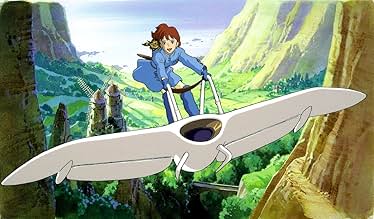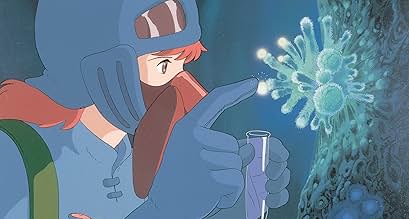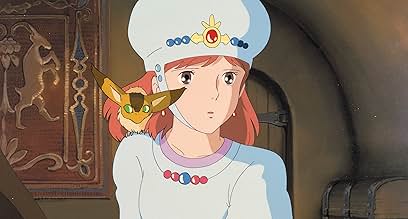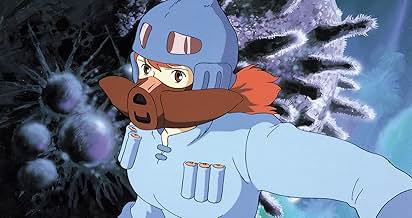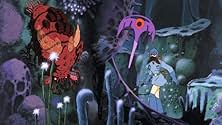La guerrière pacifiste Princesse Nausicaä lutte désespérément pour empêcher deux nations belliqueuses de détruire leur planète mourante.La guerrière pacifiste Princesse Nausicaä lutte désespérément pour empêcher deux nations belliqueuses de détruire leur planète mourante.La guerrière pacifiste Princesse Nausicaä lutte désespérément pour empêcher deux nations belliqueuses de détruire leur planète mourante.
- Prix
- 3 victoires et 1 nomination au total
- Nausicaä
- (voice)
- Jihl
- (voice)
- …
- Oh-Baba
- (voice)
- Mito
- (voice)
- Goru
- (voice)
- Gikkuri
- (voice)
- Niga
- (voice)
- Teto
- (voice)
- …
- Girl A
- (voice)
- Girl B
- (voice)
- Boy A
- (voice)
- Asbel
- (voice)
- Rastel
- (voice)
- Mayor of Pejite
- (voice)
- (as Makoto Terada)
- Rastel's Mother
- (voice)
- Kushana
- (voice)
Histoire
Le saviez-vous
- AnecdotesWhen Nausicaä was first released as an English dub in the U.S. in 1985 it was drastically cut down to 1 hour and 35 minutes and titled Warriors of the Wind. Writer and Director Hayao Miyazaki was still so upset by the truncated "Warriors of the Wind" version of Nausicaä that when Harvey Weinstein approached him to discuss the distribution to his following film Mononoke-hime (1997) and insisted on a similar heavily cut version of the movie, Miyazaki angrily left the meeting. Several days later, Studio Ghibli producer Toshio Suzuki sent a katana sword to Weinstein's office with "NO CUTS" embedded into its blade. The movie was later released in the U.S. in its uncut version. During a later interview, Miyazaki commented on the incident by smiling and stating, "I defeated him." Nausicaä was his only film to suffer heavy editing on first release. In 1995 the US rights returned to Miyazaki and he made a distribution deal with Disney. In 2003 a new English dub with Patrick Stewart and Uma Thurman was released in the uncut 117 minute (1hr 57min) version. - James LaPierre WUD Films
- GaffesDuring the climactic battle scene, the design of Oh-Baba's headband changes several times. It sometimes has gold beads instead of gold-circled turquoise beads on the end-pieces, and alternately terminates with a single or a double line of cord.
- Citations
Nausicaä: Every one of us relies on water from the wells, because mankind has polluted all the lakes and rivers. but do you know why the well water is pure? It's because the trees of the wastelands purify it! And you plan to burn the trees down? You must not burn down the toxic jungle! You should have left the giant warrior beneath the earth!... Asbel, tell them how the jungle evolved and how the insects are gaurding it so we won't pollute the earth again. Asbel please!
- Générique farfeluAs the credits roll we see life returning to normal in the valley: Kushana, Kurotowa and the Tolmekian fleet leave peacefully, after Nausicaä has unheard words for Kushana. The denizens of the Valley of the Wind replant trees in the burned-down forest. Lord Yupa and Asbel ride Yupa's beasts to the Toxic Jungle and explore it. When the text "The End" appears on screen we see Nausicaa's discarded helmet in the forest, alongside a green, non-Toxic Jungle sapling.
- Autres versionsIn the original Japanese version of the film, a World Wildlife logo praising the film is displayed at the beginning. For the US release from Disney, this logo was replaced with a typical Studio Ghibli logo.
- ConnexionsEdited into Tales of the Valley of the Wind (2009)
- Bandes originalesKaze no Tani no Naushika (Symbolic Theme Song)
Lyrics by Takashi Matsumoto
Music by Haruomi Hosono
Arranged by Mitsuo Hagita
Vocals by Narumi Yasuda (Tokuma Japan)
Technically not a Ghibli film (Miyazaki actually used the studio which did most of 'The Last Unicorn', and which more or less became Ghibli when 'Laputa' was made a couple of years later), 'Nausicaa' is a far-future SF story with a princess/warrior/nature-lover heroine and strong environmental themes. There's also an opposing princess/leader trying to use technology to overcome the apparently hostile environment. If you're starting to think 'Princess Mononoke', you'd be on the right track. In some ways 'Nausicaa' seems like an early stab in the direction of 'Mononoke', though the latter would delve far more into spirituality and mythology, eschewing the SF aspects.
There aren't really any major weak points in Nausicaa - unless you count the frustrating 12 drawings per second animation which I constantly complain about in Japanese animation. The backgrounds aren't as amazing and the animation not as good as the last few Ghibli films, but for 1984 it was plenty good enough. I have a fairly trivial complaint in that the character of Kuratowa is drawn in a slightly more 'anime' style, ala Lupin III, whereas all of the other characters are done in a realistic style. He just seems a little out of place, though he's quite delightfully drawn.
The really strong points of the movie are its pacing (at least until the very end. Miyazaki was unhappy with the end too), its story telling, which manages to be sophisticated without being impossibly complex, its engrossing background drawings and settings, - and most of all in the amazing attention to detail in the fully realized post-apocalypse SF-fantasy world in which the story is set. Every little thing is worked out and placed such that you find yourself admiring inventions, ideas, structures, creatures, etc which don't draw attention to themselves, but simply exist as part of the backdrop of the movie. Of course 'Nausicaa' had existed for several years as a serialised Manga, so Miyazaki no doubt knew its universe inside-out.
There's a very clever plot, which I won't give away, but which involves humanity's relationship with the Earth and nature.
It's the sort of movie which you can get thoroughly caught up in, and which will stand repeated viewings. It really is a film which is perfectly pitched at both a young and an adult audience. As Miyazaki's second feature film it is also, rightly or wrongly, usually considered the start of Studio Ghibli, and is arguably worth watching for historical reasons, too.
Not the very best from Miyazaki or Ghibli, but an auspicious beginning.
PS, in case you didn't know, there was a heavily butchered US version floating around called 'Warriors of the Wind', which is universally reviled as a disgrace. Just to make it confusing, some of the Japanese copies are also called 'Warriors of the Wind'. The thing to look for is the 116 minute running length. If you get that, you've got the right one. At the moment the only way you can get the film is in Japanese dialog with English subtitles. Personally I'd go ahead and do that, rather than wait while Disney squats on the US distribution rights (Amazon gives it a release date of 2010 for God's sake). You can always replace it later.
Good stuff.
- Lupercali
- 17 sept. 2004
- Lien permanent
Meilleurs choix
Détails
Box-office
- Budget
- 1 000 000 $ US (estimation)
- Brut – États-Unis et Canada
- 495 770 $ US
- Brut – à l'échelle mondiale
- 9 012 301 $ US
Contribuer à cette page








